Get rid of the old yeast, so that you may be a new unleavened batch—as you really are. For Christ, our Passover lamb, has been sacrificed.
1 Corinthians 5:7
I will give them an undivided heart and put a new spirit in them; I will remove from them their heart of stone and give them a heart of flesh.
Ezekiel 11:14-21
Last updated: Oct 25, 2025
Corresponding Emotions: Honesty, Vulnerability & Humility
This wing has 19 total flaps (exercises).
This is the shadow dance of passover which is also the dance of travail, cleaning & shadow work. This is the Festival of Spring— “Spring cleaning” the “passing over” of the forces of destruction. This was Christ’s Last Supper.
Evidently, this also becomes the dance of celebration for being clean or having the ability to go through travesty.
During Passover, Jewish tradition involved removing all traces of leavened products from homes as a symbol of spiritual purification, the removal of impurity, and a renewed commitment to living in more spiritually cleansed life.
Passover represents breaking free from bondage. We break free by placing our darkness on the cross. The passover lamb is Christ and so Christ passes over from judgement anybody who is under Christ’s blood.
The wing is also associated with Hyssop, the 6th Incense Aroma, Confession.
Humbled/Crucified Body
But he said to me, “My grace is sufficient for you, for my power is made perfect in weakness.” Therefore I will boast all the more gladly of my weaknesses, so that the power of Christ may rest upon me. For the sake of Christ, then, I am content with weaknesses, insults, hardships, persecutions, and calamities. For when I am weak, then I am strong.
2 Corinthians 12:9-10
The humbled or crucified body is the weakened body. This is the complete opposite of the pride body.
In no particular order we Clean, Repent, Offer, Surrender, and Sacrifice (CROSS) which takes a tangible form through prostration, bending, kneeling, adopting fetal positions, or standing vulnerably, much like in the manner of the ash body as exemplified in Job 30:19: ‘I am reduced to dust and ashes.’
This dance is not easy but necessary and profoundly rewarding. Each movement embodies the release of inner turmoil, echoing the Israelites’ journey to liberation from the clutches of bondage. CROSS encapsulates the spiritual metamorphosis one undergoes during this dance of repentance. Just as the Israelites stepped from enslavement into freedom, we step from shadows into light.
For outsiders new to the faith, a series of confliction or triggers may occur. Fortunately, this edge can be danced. Then one can ask oneself, was what was just danced of the clean spirit? Is there anything that can be put on the cross, burned with the holy fire of love or washed with holy water?
The Outer Tabernacle
Jesus answered, Verily, verily, I say unto thee, Except a man be born of water and of the Spirit, he cannot enter into the kingdom of God.
Matthew 5:3-6
In a similar vein to Passover’s removal of impurity, the outer court of the tabernacle was associated with various rituals of purification and offerings, representing a space of transition from the mundane to the sacred. Both the outer and inner tabernacle are completely available to those who have accepted Jesus into their heart.
The outer court presented two forms of cleansing, one that occurs first before the other. To follow the two rites is to become born again in Spirit (fire) and in holy water (water).
Fire Cleanse @ The Brazen Altar
Fire! Fire! Fire!
Repent therefore and be converted, that your sins may be blotted out, so that times of refreshing may come from the presence of the Lord.
Acts 3:19
Key: Humility, vulnerability, and courage.
This is shadow work (repentance) of sacrificing one’s sins or shadows upon the fire for the greater good of the whole body and soul. Then, by God’s grace only, one may become born again of Spirit. This is a refining.
This fire is God’s fire which is also God’s love. When not in alignment with God and so out of balance with love itself, this fire can feel like torture, which may explain the biblical expression of God’s wrath even hell.
God’s fire does not burn if we have aligned with it, and so the Beguine mystic Marguerite Porete (13th – 14thc.) says:
Now this Soul, says Love, is so burned in Love’s fiery furnace that she has become very fire, so that she feels no fire, for in herself she is fire, through the power of Love which has changed her into the fire of Love.
The outer court presented two forms of cleansing, one that occurs first before the other. To follow the two rites is to become born again in Spirit (fire) and in Holy Water.
Water Cleanse @ The Brazen Laver
Wash yourself.
First clean the inside of the cup and the plate, that the outside also may be clean.
Matthew 23:26
To cleanse with water, one must have faith and trust, as it cannot be achieved through works alone. Only then does the possibility arise of being born again through water (baptism). This is the crossing of the Red Sea. This is the crossing of the River Jordan. This is the flood of Noah’s day.
Beatitudes (Shadow Work)
The first four Beatitudes, part of the Sermon on the Mount, reflect Jesus’ teaching on how we are blessed when we take up our cross and follow Him. These Beatitudes from Matthew 5:3-6 reveal the inward journey of humility, repentance, and renewal:
- Blessed are the poor in spirit, for theirs is the kingdom of heaven.
- Blessed are those who mourn, for they will be comforted.
- Blessed are the meek, for they will inherit the earth.
- Blessed are those who hunger and thirst for righteousness, for they will be filled.
The first four Beatitudes reflect the stages of repentance (true shadow work).
- Awareness: You recognize a shadow or sin in your life that cannot be fixed on one’s own. (Blessed are the poor in spirit.)
- Remorse: You feel genuine sorrow for your shadow. (Blessed are those who mourn.)
- Turning Away: You renounce shadow and commit to walking in humility and surrender to God’s will. (Blessed are the meek.)
- Transformation: You develop a deep desire for righteousness and allow God’s renewal to fill you. (Blessed are those who hunger and thirst for righteousness.)
Dance of Transformation/Resurrection/Rebirth
He brought me up out of the pit of destruction, out of the miry clay, and He set my feet upon a rock making my footsteps firm.
Proverb 40:20
For a just man falleth seven times and riseth up again.
Proverbs 24:16
All believers go through a dark night of the soul of which there is always the daybreak that follows. The final 4 Beatitudes describe the outward qualities and actions that arise from an inwardly transformed life. They showcase the positive fruits of living in God’s kingdom:
5. Blessed are the merciful.
6. Blessed are the pure in heart.
7. Blessed are the peacemakers.
8. Blessed are those who are persecuted for righteousness’ sake.
Becoming The Pain of The World
When he saw the crowds, he had compassion on them, because they were harassed and helpless, like sheep without a shepherd.
Matthew 9:36
The world is full of lost souls. Dancing the Pain of the World is an exploration into the suffering of our neighbors. Witnesses embody the struggles of the afflicted, fostering compassion. This is an intercessional dance for those who are suffering.
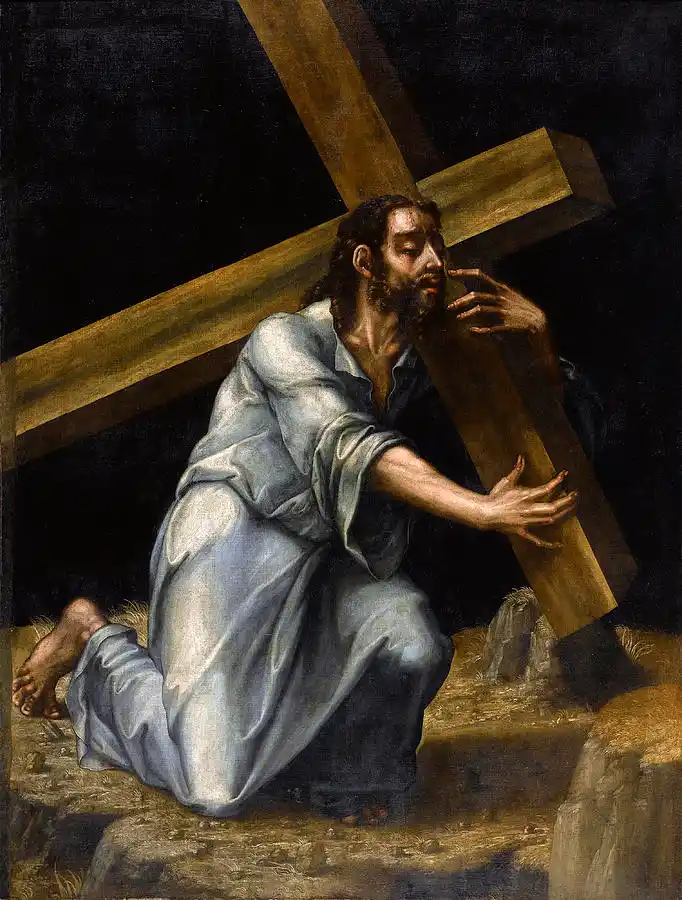
This is a lesser-scale representation of Jesus’ passion, wherein he absorbed the world’s pain onto himself, the greatest act of unconditional love known. The Passion is the epitome and ultimate embodiment of Dancing the Pain of the World.
Pain of the World Actions
Kensington
Kensington is a neighborhood in northeast Philadelphia that has been experiencing a severe street opioid and tranq crisis. The streets are full of slow-moving, slouched over, collapsed, and suspended in stillness victims of drug abuse. The scene is horrifying, reminiscent of a hell on earth. There are many Kensingtons in the world to a lesser degree.
Kindred
Kindred is the name of a chain of a long term acute centers spanning the USA. The patients admitted to Kindred are incredibly sick, bedridden, often on ventilators, and some in comas.
Death Row
I see inmates on death row in the fall of modern civilization and in the family crest of its good sense. I see the original form of my dance in their walk.
Tatsumi Hijikata1
11 Flaps
2.1: Danced By The Cross
Participants embark on a quest to find two sticks, and upon discovery, they use a piece of string to bind them into the shape of a cross. In the spirit of Kazuo Ohno’s approach, where once he allowed a rose to dance him (not the other way around), here it is the cross that takes the lead, guiding the participant in the dance.
2.2: The Art of Walking Slow
Within a thought so great,
our souls Little and modest grow,
And, by its vastness awed,
we learn The art of walking slow.
Frederick William Faber (1814 – 1863)
Fundamental to the butoh world is knowing the slow walk or ash walk. In Faber’s hymn called The Thought of God, it is thinking about God which is what makes us modest and learn to walk slowly.
Video Clip Example: In the Theokinesis piece A Living Sacrifice from 18:52 to 19:15, one engages in an ash walk of holding a dove near the heart and gradually extending the arms toward the people in offering.
2.3: Waterfall Solace
This is an across the floor psychodrama. Take time to locate a recent negative emotion such as resentment, anger, shame, or guilt and hold it solid as if the whole body were one solid piece of rock. This will be a slow stone walk that gradually transforms into a waterfall which is a blessing from angels. The waterfall erodes the rough edges down into a smooth pebble that one holds in the hand as a precious object symbolizing God’s mercy and one’s new body of flesh. Dance the new body of flesh.
2.4: Life Review
This is another across the floor psychodrama. Begin at one end of the room in fetal position and begin the passage of life from birth to one’s current age. Every step of the way, live out both negative and positive moments in one’s life. Christ’s Love is with you every step of the way like a parent. Once the current age is reached, take any regrets or guilts from the past and put them on the cross. Dance the new body.
2.5: Palms Over The Face
Cover the face with the palms and simply feel what occurs within the body. The hands are like an open book, one’s book of life, even the Bible. Judge yourself, lovingly. Move what is being felt.
2.6: Silent Scream
I cried unto the Lord with my voice; with my voice unto the Lord did I make my supplication.
Psalm 142:1
In hyper slow motion, express a deep, inaudible cry of the soul through facial expression and a silent, open-mouthed gesture, embodying the Psalms’ raw cry to God.
2.7: Contraction Burden
Cast your burden upon the Lord, and he will sustain you.
Psalm 55:22
Contract the entire body into a fetal position tightly. Hold for a good 5 or 10 seconds. Release your burdens to Lord Jesus Christ.
2.8: Stones Burden
When you were dead in your sins and in the uncircumcision of your flesh, God made you alive with Christ.
Colossians 2:13-15
Look for stones that represent one’s darkness or sins. Either another person or the participant places each stone at various parts of the body such as: (1) under the arms; (2) under the legs; (3) under the neck; (4) back of the hands; (5) on the shoulders; (6) on the head.
Slowly, one walks with these burdens until reaching the end of a space of the cross where these rocks are then released. It is Jesus that delivers us from our burdens.
2.9: Blinded By The Light
Suddenly a light from heaven flashed around him. He fell to the ground and heard a voice say to him, “Saul, Saul, why do you persecute me?”
“Who are you, Lord?” Saul asked.
“I am Jesus, whom you are persecuting,” he replied. “Now get up and go into the city, and you will be told what you must do.”
The men traveling with Saul stood there speechless; they heard the sound but did not see anyone. Saul got up from the ground, but when he opened his eyes he could see nothing. So they led him by the hand into Damascus. For three days he was blind, and did not eat or drink anything.
Acts 9:3-9
One begins as a nonbeliever, but by Jesus’s mercy, one is knocked down and made blind. There is a dance of the stricken blindness until eventually (scripturally due to Ananias), Saul is healed and lives a new life as a believer.
2.10: St. Faustina Walk
O Christ, may delights, honor and glory be Yours, and suffering be mine. I will not lag one step behind as I follow You, though thorns wound my feet.
Diary of Saint Maria Faustina Kowalska (Entry 70)
Walk as the passage from Saint Faustina describes with thorns wounding the feet.
2.11: Blue Flower
This is an across the floor psychodrama for depression based in Aaron Beck’s Triad Model of irrational beliefs about: (1) the self; (2) the world; (3) the future.2
The enemy gives a list of 4 or more irrational put down statements. With every line, the body collapses more than before, till by the time the last (or 4th) line is reached, the participant is one lump of feces on the ground. At this point, the participant dies/surrenders and mixes into the earth, creating a very fertile soil. Your soul reaches out for the tiniest seed. The seed is Christ. Gradually, this seed is allowed to blossom into a flower. The flower is a very beautiful blue color. What once was blue and sad is now a heavenly blue shining with God’s grace.
To see what the inner tabernacle is all about, see the worship page.
7 Chains (Folly Bodies)
Very truly I tell you, everyone who sins is a slave to sin.
John 8:34
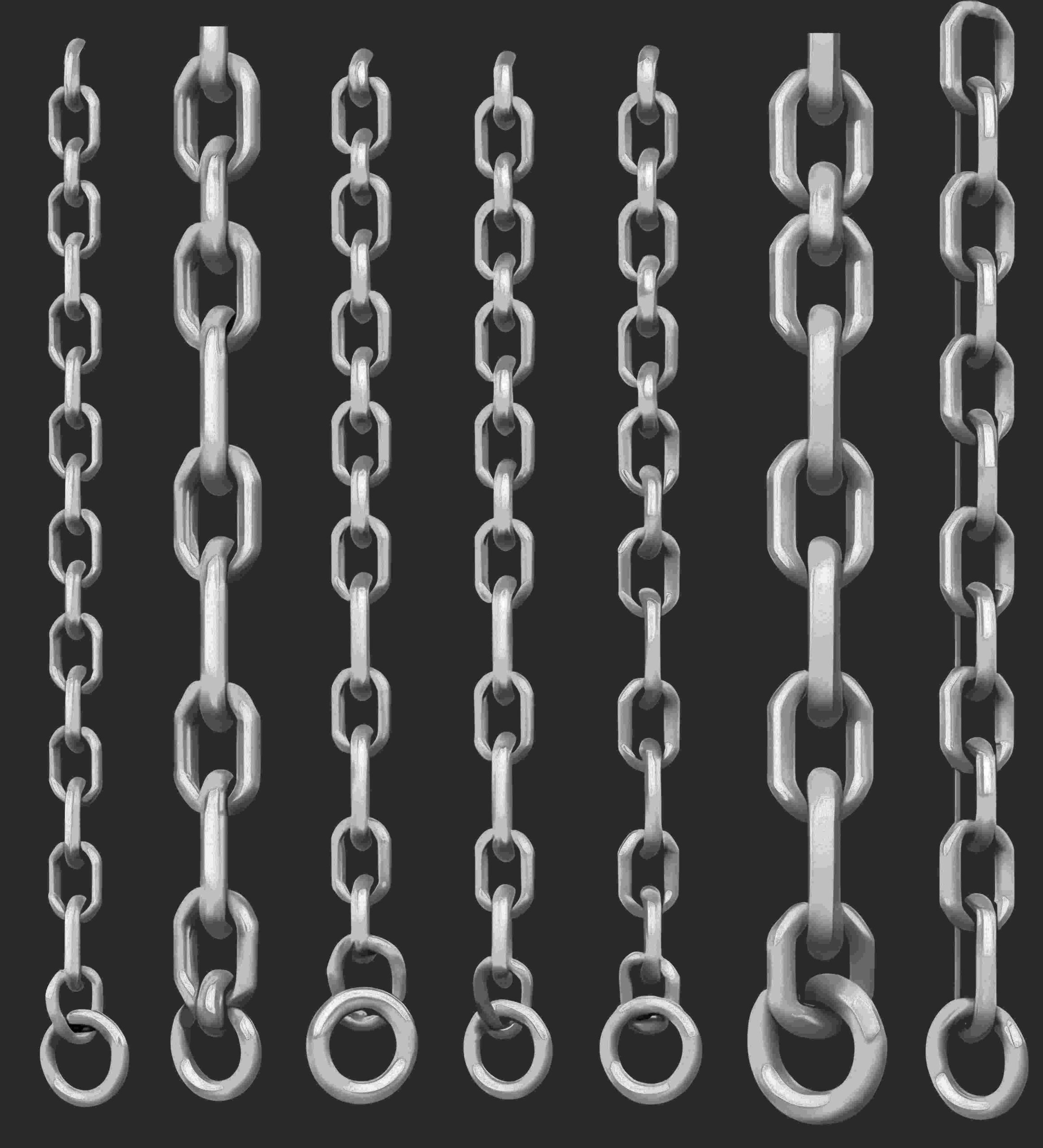
The states of the 7 weakened bodies signify an individual’s lowest, debilitated condition following their submission to the 7 deadly shadows (vices/sins), which include: (1) pride; (2) greed; (3) lust; (4) gluttony; (5) sloth; (6) envy; (7) wrath.
Every shadow leads to a breakdown in the capacity to further entertain these darker inclinations. From a theatrical perspective, the only shadow we will deliberately avoid engaging with completely is lust. This shadow is profoundly parasitic, and even exploring it within a theatrical context can potentially lead to possession by a Jezebel/Lilith-type demon.
Once the debilitated states are experienced, the goal is to put them on the cross as sacrifice. The resurrection that occurs by the glory of Christ absolves the individual from the shadow. Then the reborn healthy body is danced in celebration.
The states of the 7 weakened bodies signify an individual’s lowest, debilitated condition following their submission to the 7 deadly shadows (vices/sins), which include: (1) pride; (2) greed; (3) lust; (4) gluttony; (5) sloth; (6) envy; (7) wrath.
Every shadow leads to a breakdown in the capacity to further entertain these darker inclinations. From a theatrical perspective, the only shadow we will deliberately avoid engaging with completely is lust. This shadow is profoundly parasitic, and even exploring it within a theatrical context can potentially lead to possession by a Jezebel/Lilith-type demon.
Once the debilitated states are experienced, the goal is to put them on the cross as sacrifice. The resurrection that occurs by the glory of Christ absolves the individual from the shadow. Then the reborn healthy body is danced in celebration.
6 Flaps
2.12: The Mad King (Pride)
Pride goes before destruction, a haughty spirit before a fall.
Proverbs 16:18
This is a character study of The Mad King. The Mad King is based in pride. Pride is said to be the first sin and is what leads to the others. The participant enters into the character of The Mad King. The intensity gradually increases until a peak is reached (a Tower of Babel moment) in which a sudden lightning bolt strikes and topples The Mad King’s tyranny. The following then is a dance of humility, a weakened body floor dance. The dance ends in a gratitude for no longer being possessed by The Mad King.
2.13: You Can’t Eat Money (Greed)
An emaciated body continues to accumulate wealth and objects yet is unaware that it will never lead to a nurtured soul or everlasting life. Put the vice on the cross. Dance the resurrection.
2.14: Mouth (Gluttony)
One becomes a big mouth, constantly consuming and experiencing the accumulating burden, yet never finding contentment. The consumption grows to such an extent that one can take no more and places this curse on the cross. Dance the resulting celebration.
2.15: Senile Death Match (Wrath)
The competition unfolds within a fighting circle. Two participants, although entirely incapacitated to the extent that they cannot engage in any form of combat whatsoever, try to fight anyway.
2.16: Deflated Balloon (Sloth)
One moves across the floor in a sloth-like manner. The body adopts a slouched, sometimes fully deflated position, yet at the same time manages to move across the space. Focus on embodying feelings of indifference and sleep to the point of death. Dance the resurrection.
2.17: Green-eyed Monster (Envy)
O beware, my lord, of jealousy; It is the green-eyed monster which doth mock the meat it feeds on.
Shakespeare (Othello 3:3)
Dance Shakespeare’s green-eyed monster until its own logical demise then the resurrection.
Gargoyles & Guardians (Guardoyles)
Church gargoyles are guardians (or guardoyles). They appear only externally on the architecture of churches, especially on Gothic cathedrals. They serve the function of a gatekeeper since they are like a filter or bridge between the church and the world. Despite being in the margins, they still serve The Good. They can be of as Lord’s guard dogs.
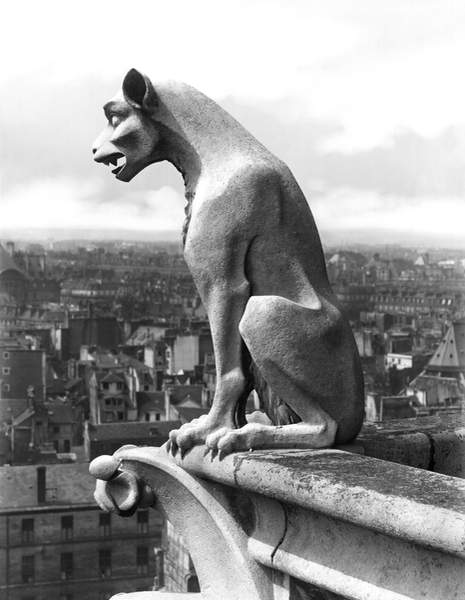
In butoh, a number of characters can present themselves in the body that are animalistic, monstrous, awkward, debilitated, or ugly. Yet nature itself often has these same characteristics. The real question to be asked is whether whatever comes out honors Jesus Christ. If yes, respect the entity as an important component of our inner ecosystem. If not, put it on the cross.
Saint Christopher
Saint Christopher is among the most unusual of saints and can be an example of a gargoyle-type figure. He is even sometimes depicted with a dog head. He is listed as a martyr by the Catholic and Orthodox Church. His story:
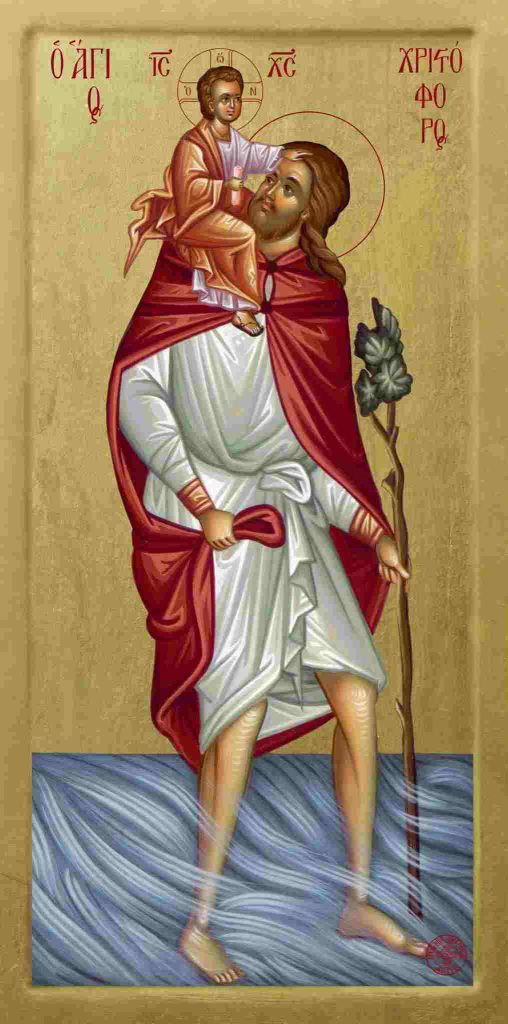
St. Christopher, a 7.5 ft Canaanite, sought to serve the greatest king and initially served a local ruler. However, upon realizing the ruler feared the Devil, Christopher decided to serve the Devil himself. During his quest, he encountered a band of thieves led by one who claimed to be the Devil. Yet, when this leader avoided a Christian cross, Christopher discovered a power greater than the Devil.
Guided by a hermit, Christopher learned about Christ, the King of Kings, and was advised to find a way to please Him. Choosing to work at a dangerous river, Christopher helped travelers cross, an act that pleased Christ. One day, a child approached him, and as Christopher carried the child across the river, the weight became immense. When St. Christopher asked why he was so heavy, the child stated He was the Christ and when St. Christopher carried Him, he also carried the weight of the whole world on his shoulders. The child then vanished.3
Both the gargoyle and St. Christopher serve to safeguard individuals from physical and spiritual harm. They stand at the threshold between the sacred and the profane, the earthly and the divine. They both serve as a good reminder that during shadow work, we are not to haphazardly banish everything to the point of also banishing things that serve The Good.
Always pray to Jesus Christ for the guidance in discernment and true equilibrium.
Saint John the Baptist
John the Baptist stands as another figure deeply aligned with the symbolism of the gargoyle and Saint Christopher—one who exists at the threshold between worlds, serving as a bridge, a herald, and a guardian of spiritual transformation.
John emerges from the wilderness, clothed in camel’s hair, eating locusts and wild honey (Matthew 3:4). His wild, untamed appearance mirrors the raw, untethered essence often seen in gargoyles or the unsettling figures that arise in butoh dance—awkward, primal, and stripped of societal polish. Yet, his wilderness state serves a profound purpose: it signifies his role as one unbound by worldly corruption, standing outside societal norms to speak prophetic truth.
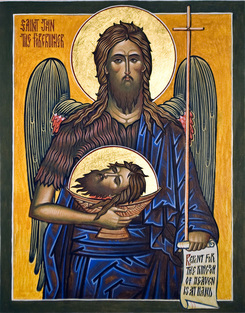
John’s wildness is not chaos but clarity—a voice crying out in the wilderness: “Prepare the way of the Lord, make straight paths for Him” (Matthew 3:3).
John serves as a liminal figure, standing at the intersection of the Old Covenant and the New Covenant. He is the last prophet of the Old Testament era and the forerunner of the New Testament promise. His baptism in the Jordan River marks a sacred boundary—a ritual cleansing that symbolizes repentance and prepares people to meet Christ.
Much like a gargoyle guards the threshold of a church and Saint Christopher carries souls across the river, John the Baptist stands at the gateway of repentance, guiding others into spiritual renewal. His message is uncompromising: “Repent, for the kingdom of heaven has come near” (Matthew 3:2).
Yet, John knows he is not the destination but the guide. When asked about his role, he humbly declares: “He must become greater; I must become less” (John 3:30). Like Saint Christopher, who carries Christ across the river, John carries souls through the waters of baptism to meet Christ on the other side.
2 Flaps
2.18: Pass the Monster
This is a mirroring exercise within a group circle. One individual acts out their inner shadow or monster. This entity is passed around in a circle. Once the entity is passed, the passer returns to a neutral state. We try to get the entity rotating around as quickly as possible. Mirroring the sounds as well. Once the entity returns to the original person, it is acted out one more time and then phased out. This participant privately decides whether this is a gargoyle that serves The Good or one that needs to be put on the cross.
2.19: A Creature Who Loves God
Several Christian mystics such as Julian of Norwich, Meister Eckhart, John of the Cross, and Hildegard of Bingen referred to humans as creatures as a sign of humility, dependence on God, and the divine relationship with the created world. But we can take it a step further and really become creatures in more the sense that we know the word but ones that still love God. Dance a lighthearted creature who loves God.
This is not mockery even though some may perceive it as such, but rather, it emphasizes a playful, lighthearted way in which to honor God.
Shadows Within Christiandom
Theokinesis is meant to be a diverse exploration of Christianity’s entire scope throughout history up until today. Through the shadow wing, the darkness, or Christian man’s falling short of God’s glory within the faith can be put into the spotlight, explored, and processed.
Christian shadows can involve: (1) divine violence, (2) religious nationalism, (3) condemnation, (4) empty worship, (5) idolatry of Scripture, and (6) Prosperity gospel. The list is not exhaustive.
Everything we treasure must be tested, examined, and wrestled with if we hope to understand it truly—otherwise we slip into blind faith. Theokinesis invites us to dance our questions, to move with the parts of Christian faith that unsettle us, so that discomfort becomes a doorway to deeper truth.